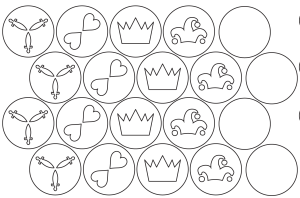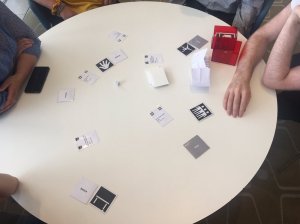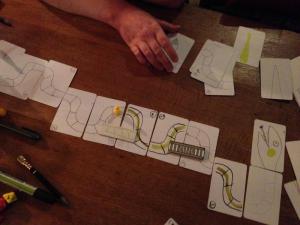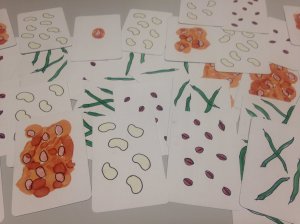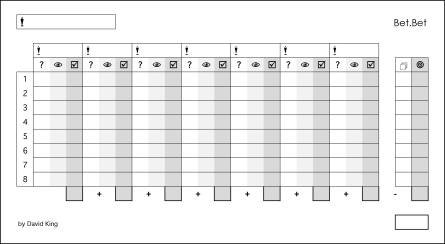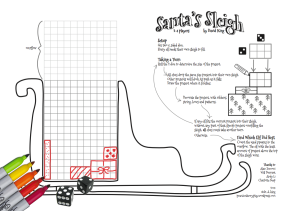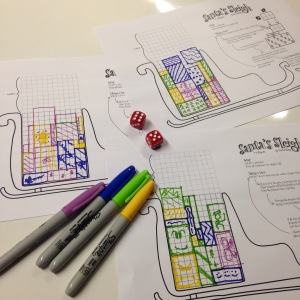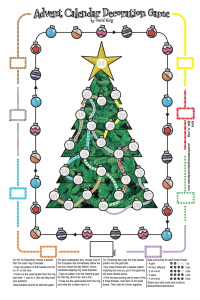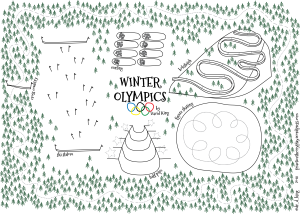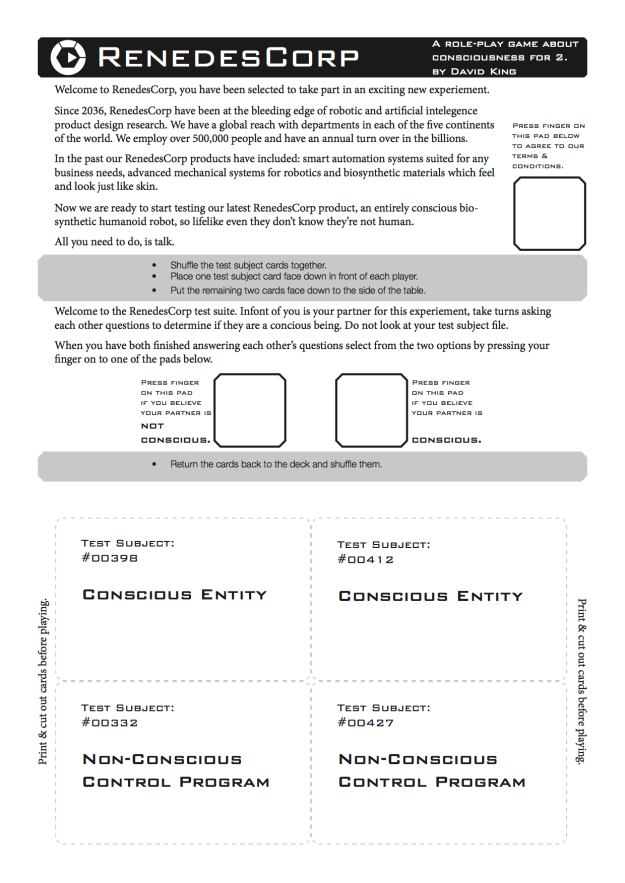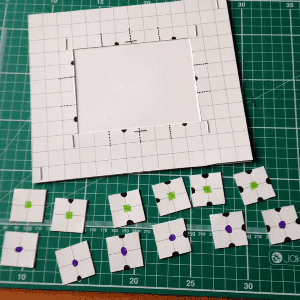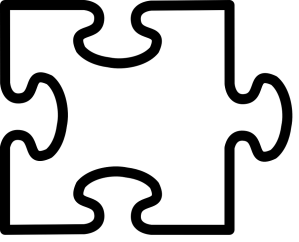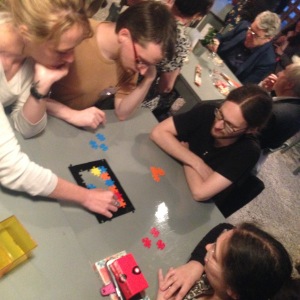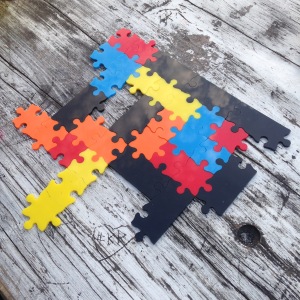
I was recently asked to create a workshop for a conference that would introduce a small group (around 25) to concepts of play for work. Over the last few years I have come to dislike words like gamification, edutainment, or serious games, and what they stand for, but had not really spent much time thinking about why.
There is this idea that if only we could make things which we are not motivated to do more fun, then we would want to do them more. Also games are fun, people often like playing games. So therefore we should make: work, training, learning, education, study, eating well, and exercise more like games, then they will be fun too, and we will enjoy doing them. At least that’s what the plan usually is.
The issue is not only that the execution of this concept is poorly done, but there are often more fundamental issues with it in the first place. Not every task is suited for being made a game of. However, amongst all the mess, there are some good examples of games being used in serious ways, which I will try to highlight later on.
So, I had to prepare a workshop, but I didn’t want it all to be negative, I wanted there to be some positive outcomes for the people who attended. It was also important for me that they went away with more than a simplified idea of how games and work can be mixed.
I observed that there are four broad approaches to mixing work and play, each with their benefits and issues in different amounts. I will go through them one at a time, giving the example of the activity I had the attendees of the workshop complete.
1. Rewards, Badges, Points and Medals.
This is the easiest way to gamify any activity. When tasks are completed, the player is awarded a small reward. The more tasks completed the more rewards are gained. Players can compete with each other to see has the most rewards, encouraging engagement with the game.
It is possible to add timing, reminders, and a little bit of randomness to increase the engagement of the players, see Skinner Box and Operand Conditioning if you are interested in learning more and research out from there, also look at the free-to-play mobile gaming market.
The activity: When the participants entered the room, an equal mixture of black and blue chairs were set out, there were more seats than participants. The group was split into two teams. Each team was tasked with gathering and stacking all the chairs of their teams colour to the side of the room, maximum stack size of five chairs.
Stickers were rewarded for certain tasks completed.
- First chair moved.
- Third chair moved.
- Placed the last chair on the stack.
- Placed the last chair on the stack three times.
- On the team that stacked all their chairs the quickest.
Thoughts: The participants did not really enjoy staking chairs, and could see they were being manipulated.
In situations where the person wants to achieve something, is capable of achieving it, but perhaps is not intrinsically motivated to do something, rewards can potentially help. Also, if the activity is optional and engaging, this additional motivation can help. The issue is being forced into a system of rewards and being manipulated, or being told something is now fun because of stickers. Another issue is that people can become reliant on extrinsic rewards. Removing these reward risks removing the desire to complete the original task, even in cases where the person originally enjoyed the task itself.
2. Incidental Outputs of Game are Work
This is a little harder to describe, but the idea is as follows. Sometimes when playing a game, things which are not a major aspect or goal of the game also occur. If the game can be created in such a way that these outcomes are useful, then they could potentially be harnessed for work. For example, although Civilization (Sid Meier) does not explicitly test your knowledge of history, players often get a better grasp of historic events and time periods. Pokémon GO, asks you to collect Pokémon, but to do so successfully requires you to walk around (there are also motivations of play more similar to 1. within Pokémon GO). A really good example of this is how playing games can reduce pain felt (google: reduce pain with games). These games are not designed as training tools for not feeling pain but simply playing games in itself is distracting/engaging enough for it to work.
The activity: I had the participants play Connect-4 with the chairs, placing them in turn into the room. Although the group is focussing on trying to win the game, the nature of the activity means that the chairs were placed in such a way that they could be used as seating again, i.e. returning them to a state similar to when they entered the room.
Thoughts: The participants enjoyed this activity a lot more, however, they noted that it was not an efficient way of completing the task. In general it would have perhaps been a better use of their time to just get the job done, and then move on to something else. The other issue is, an example with placing chairs was relatively easy to determine a game for, but coming up with a truly engaging game with incidental outputs for many jobs, tasks or training would be quite a difficult feat of design.
3. Layered Gaming
In 2. the issue was designing a game that had in game incidental outputs that equated to the none engaging work that was original required. The idea of layered gaming is to further separate the game and the work. Have a game which can be played in parallel to work, an alternative reality that is happening in the same space and time. Depending on the type of work which is required the game must be selected so that it does not interfere with it directly. So whilst doing physically intensive work a thoughtful word or memory game could be played, or vice-versa.
The activity: Whilst stacking the chairs away for the second time, each player was given two scrabble tiles. The players had to form groups which would create the longest work. All players in the group with the longest words would be declared the winners.
Thoughts: In this instance this lead to quite a bit of distraction and not a whole lot of stacking chairs. With more consideration between the choice of game and the work/training activity I think there could be potential in the idea. The difficulty is making the game not interfere negatively with the original task.
4. Just Play
One option, and probably the simplest, is just to make time to play and games. I find it a good way for people to get to know each other. Games allow interaction through systems, and give space for people to both talk about something specific (the game) and about other things in between. There is also opportunity to not say anything and just engage with the game, meaning long awkward silences are far less likely. Finally, games create stories and moments that people can relate to later, and in the case of non-digital games people have to share a space.
The activity: For this example we played a variation of Lemon Joust a game brought to the world by Minkette. Players each balance a lemon on a wooden spoon. When the game begins the players attempt to knock off other players’ lemons with their spoon. Players who have their lemon knocked off are eliminated, the winner is the last remaining player with a lemon on their spoon.
Thoughts: The majority of the participants seemed to enjoy playing or watching the game. This method of just allowing play seems the most honest and least manipulative of the four suggestions. Not to say there are not certain scenarios where each could be appropriate, if well developed. This method is probably the cheapest, but for some reason perhaps the hardest to justify as there is no work being done. All you need to do is a little research and identify some great games for groups of people. With the recent resurgence in board, card and party games there are plenty to choose from. Check out ShutUpAndSitDown for some ideas of games to play.
Final thoughts
Overall I believe the workshop was a success, the participants seemed to enjoy it and gave positive feedback. Of the four activities, lemon joust and connect-4 were the most popular.
There is clearly a spectrum of approaches to mixing games and work. All the way from having games and work embedded in the same system through to having them completely separate from each other.
There is plenty of challenges in making them work together well, and in some cases it may be worth it. However, in my opinion, both the cheapest, simplest and most honest solution is to just create time for play and games, as a different activity to work. This way, there is clearly no manipulation and those that do not want to participate do not have to.
